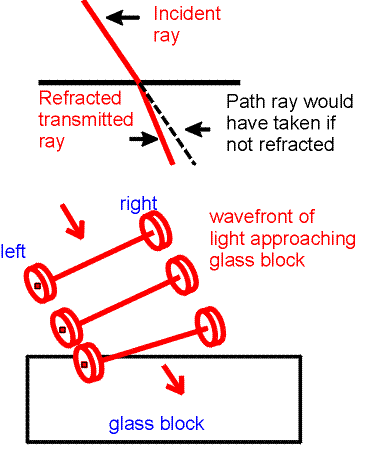 I will explain why the light rays bend when going from air to glass by making use of an analogy. Imagine that the wave fronts of light approaching the glass block is something like a pair of wheels rolling on concrete. On the concrete the resistance of each wheel is the same so they travel in a given direction without turning. The wheels are approaching a sandy area.
I will explain why the light rays bend when going from air to glass by making use of an analogy. Imagine that the wave fronts of light approaching the glass block is something like a pair of wheels rolling on concrete. On the concrete the resistance of each wheel is the same so they travel in a given direction without turning. The wheels are approaching a sandy area.Assume that the glass block is like a sandy beach. When the left wheel reaches the sand it slows down while the right wheel continues at its original speed. As a result, the axle turns a little changing the direction that the wheels move. When the right wheel reaches the sand it slows down and moves at the same rate as the left wheel.
Can you image what happens when the wheels reach the other side of the sandy area?
The left wheel emerges from the sane first and speeds up, thus turning the axle in the other direction. When the right wheel is out of the sand it travels at the same rate as the left wheel.
Of course lights are not wheels and sand, although it can be used to make glass, is not a glass block. Nevertheless, the analogy makes its point.
Light really operates according to Snell's law
Table of Contents
Subject Index
Table of Contents [When not using framtes]